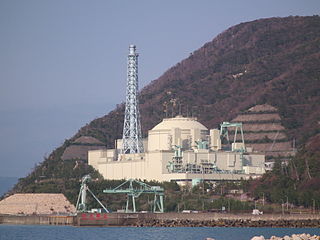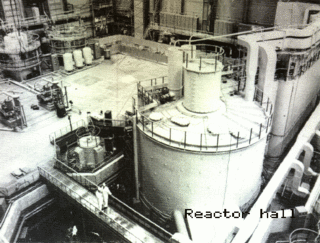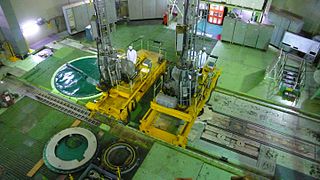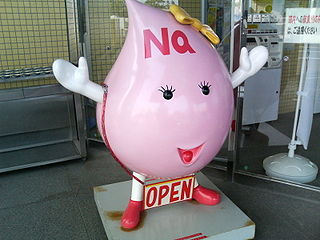Related Research Articles

A breeder reactor is a nuclear reactor that generates more fissile material than it consumes. These reactors can be fuelled with more commonly available isotopes of uranium and thorium, such as uranium-238 or thorium-232, as opposed to the rare uranium-235 which is used in conventional reactors. These materials are called fertile materials since they can be bred into fuel by these breeder reactors.

Mitsubishi Heavy Industries, Ltd. is a Japanese multinational engineering, electrical equipment and electronics corporation headquartered in Tokyo, Japan. MHI is one of the core companies of the Mitsubishi Group and its automobile division is the predecessor of Mitsubishi Motors.

Phénix was a small-scale prototype fast breeder reactor, located at the Marcoule nuclear site, near Orange, France. It was a pool-type liquid-metal fast breeder reactor cooled with liquid sodium. It generated 590 MW of thermal power, and had a breeding ratio of 1.16, but normally had to be stopped for refueling operations every two months. Phénix continued operating after the closure of the subsequent full-scale prototype Superphénix in 1997. After 2004, its main use was investigation of transmutation of nuclear waste while also generating some electricity. Phénix was shut down in 2009.

Monju (もんじゅ) was a Japanese sodium-cooled fast reactor, located near the Tsuruga Nuclear Power Plant, Fukui Prefecture. Its name is a reference to Manjusri. Construction started in 1986 and the reactor achieved criticality for the first time in April 1994. The reactor has been inoperative for most of the time since it was originally built. It was last operated in 2010 and is now closed.

A fast-neutron reactor (FNR) or fast-spectrum reactor or simply a fast reactor is a category of nuclear reactor in which the fission chain reaction is sustained by fast neutrons, as opposed to slow thermal neutrons used in thermal-neutron reactors. Such a fast reactor needs no neutron moderator, but requires fuel that is relatively rich in fissile material when compared to that required for a thermal-neutron reactor. Around 20 land based fast reactors have been built, accumulating over 400 reactor years of operation globally. The largest of this was the Superphénix Sodium cooled fast reactor in France that was designed to deliver 1,242 MWe. Fast reactors have been intensely studied since the 1950s, as they provide certain decisive advantages over the existing fleet of water cooled and water moderated reactors. These are:

Indira Gandhi Centre for Atomic Research(IGCAR) is one of India's premier nuclear research centres. It is the second largest establishment of the Department of Atomic Energy (DAE), next to Bhabha Atomic Research Centre (BARC), located at Kalpakkam, 80 km south of Chennai, India. It was established in 1971 as an exclusive centre dedicated to the pursuit of fast reactor science and technology, due to the vision of Dr. Vikram Sarabhai. Originally, it was called as Reactor Research Centre (RRC). It was renamed as Indira Gandhi Centre for Atomic Research(IGCAR) by the then Prime Minister of India, Rajiv Gandhi in December 1985. The centre is engaged in broad-based multidisciplinary programme of scientific research and advanced engineering directed towards the development of Fast Breeder Reactor technology, in India.
Generation IV reactors are nuclear reactor design technologies that are envisioned as successors of generation III reactors. The Generation IV International Forum (GIF) - an international organization that coordinates the development of generation IV reactors - specifically selected six reactor technologies as candidates for generation IV reactors. The designs target improved safety, sustainability, efficiency, and cost. The first commercial Gen IV plants are not expected before 2040–2050, although the World Nuclear Association in 2015 suggested that some might enter commercial operation before 2030.

A sodium-cooled fast reactor is a fast neutron reactor cooled by liquid sodium.

Madras Atomic Power Station (MAPS) located at Kalpakkam about 80 kilometres (50 mi) south of Chennai, India, is a comprehensive nuclear power production, fuel reprocessing, and waste treatment facility that includes plutonium fuel fabrication for fast breeder reactors (FBRs). It is also India's first fully indigenously constructed nuclear power station, with two units each generating 220 MW of electricity. The first and second units of the station went critical in 1983 and 1985, respectively. The station has reactors housed in a reactor building with double shell containment improving protection also in the case of a loss-of-coolant accident. An Interim Storage Facility (ISF) is also located in Kalpakkam.

Prior to the 2011 Tōhoku earthquake and tsunami, Japan had generated 30% of its electrical power from nuclear reactors and planned to increase that share to 40%. Nuclear power energy was a national strategic priority in Japan. As of March 2020, of the 54 nuclear reactors in Japan, there were 42 operable reactors but only 9 reactors in 5 power plants were actually operating. A total of 24 reactors are scheduled for decommissioning or are in the process of being decommissioned. Others are in the process of being reactivated, or are undergoing modifications aimed to improve resiliency against natural disasters; Japan's 2030 energy goals posit that at least 33 will be reactivated by a later date.

The BN-600 reactor is a sodium-cooled fast breeder reactor, built at the Beloyarsk Nuclear Power Station, in Zarechny, Sverdlovsk Oblast, Russia. Designed to generate electrical power of 600 MW in total, the plant dispatches 560 MW to the Middle Urals power grid. It has been in operation since 1980 and represents an evolution on the preceding BN-350 reactor. In 2014, its larger sister reactor, the BN-800 reactor began operation.
A liquid metal cooled nuclear reactor, or LMR is a type of nuclear reactor where the primary coolant is a liquid metal. Liquid metal cooled reactors were first adapted for breeder reactor power generation. They have also been used to power nuclear submarines.

Marcoule Nuclear Site is a nuclear facility in the Chusclan and Codolet communes, near Bagnols-sur-Cèze in the Gard department of France, which is in the tourist, wine and agricultural Côtes-du-Rhône region. The plant is around 25 km north west of Avignon, on the banks of the Rhone.
The Prototype Fast Breeder Reactor (PFBR) is a 500 MWe fast breeder nuclear reactor presently being constructed at the Madras Atomic Power Station (MAPS) in Kalpakkam, India. The Indira Gandhi Centre for Atomic Research (IGCAR) is responsible for the design of this reactor. The facility builds on the decades of experience gained from operating the lower power Fast Breeder Test Reactor (FBTR). Originally planned to be commissioned in 2010, the construction of the reactor suffered from multiple delays. As of December 2022, the Prototype Fast Breeder Reactor was expected for completion in 2024.

The Power Reactor and Nuclear Fuel Development Corporation (PNC) or 動燃 for short, was a Japanese nuclear energy research organization established 2 October 1967 with the Atomic Fuel Corporation as its parent organization and disbanded in 1998 to be restructured as the Japan Nuclear Cycle Development Institute. The organization specialized in special Breeder reactors and the Advanced Thermal Reactor. It also owned a nuclear reprocessing facility and its activities included uranium exploration in Australia and disposal of high-level waste.

Jōyō (常陽) is a test sodium-cooled fast reactor located in Ōarai, Ibaraki, Japan, operated by the Japan Atomic Energy Agency. The name comes from the previous country name of the area around Ibaraki.
Atmea was a joint venture between Mitsubishi Heavy Industries (MHI) and EDF Group set up in 2006 to develop, market, license and sell the ATMEA1 reactor, a new generation III+, medium-power pressurized water reactor (PWR). The company was headquartered in Paris. The joint venture was abandoned in 2019.
The Mitsubishi advanced pressurized water reactor (APWR) is a generation III nuclear reactor design developed by Mitsubishi Heavy Industries (MHI) based on pressurized water reactor technology. It features several design enhancements including a neutron reflector, improved efficiency and improved safety systems. It has safety features advanced over the last generation, including a combination of passive and active systems. None are currently under construction.

TerraPower is an American nuclear reactor design and development engineering company headquartered in Bellevue, Washington. TerraPower is developing a class of nuclear fast reactors termed traveling wave reactors (TWR).
ASTRID was a proposal for a 600 MW sodium-cooled fast breeder reactor, proposed by the Commissariat à l'énergie atomique (CEA). It was to be built on the Marcoule Nuclear Site in France. It was the successor of the three French fast reactors Rapsodie, Phénix and Superphénix.
References
- ↑ "MHI Establishes New Company for FBR Development". Japan Corporate News Network. 25 June 2007. Archived from the original on 30 June 2013.
- ↑ "New fast breeder reactor for Japan". Nuclear Engineering International. 6 June 2006. Archived from the original on 13 June 2011. Retrieved 16 March 2011.
- ↑ Tara Patel, Gregory Viscusi (5 May 2014). "Japan to Work With France on Future Fast-Breeder Atomic". Bloomberg. Retrieved 3 December 2016.
- ↑ "France wants Japan to share 570 billion yen ASTRID reactor development cost". The Mainichi. 22 October 2016. Retrieved 3 December 2016.
- ↑ Geert De Clercq (30 August 2019). "France drops plans to build sodium-cooled nuclear reactor". Reuters. Retrieved 15 January 2022.
- 1 2 "US, Japanese firms agree to cooperate on fast reactors". World Nuclear News. 27 January 2022. Retrieved 31 January 2022.
